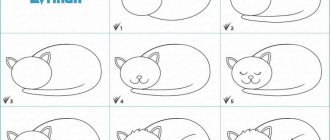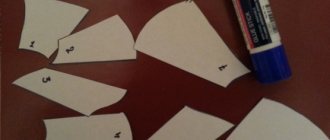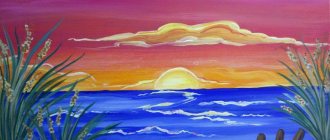On the topic: methodological developments, presentations and notes
Abstract of OOD on artistic design in the middle group.
Goal: expanding and enriching children’s knowledge about “mushrooms”, “berries”, their habitat, purpose, time of collection; generalization of children's knowledge about mushrooms and berries of our forests. Final m.
Calendar-thematic planning in the middle group on the topic “Wild berries and mushrooms.”
Using this material, it is easy and simple to introduce children to wild mushrooms and berries.
Introduce children to wild berries; teach children to distinguish between garden and forest berries; to educate children to respect nature. Materials and equipment: posters with images of berries; ill.
Source
Motivation
As visual materials on the topic, you can offer pictures of different forest animals that feed on berries and mushrooms
The involvement of children in work depends on how much the teacher manages to interest them in the topic. To do this, you can use a whole arsenal of techniques, combining them depending on the topic and time frame of this stage of the lesson.
Songs
Musical accompaniment of classes allows not only to create a favorable atmosphere in the children's group, but also to present the necessary information in an unobtrusive form, for example, about what edible mushrooms look like. Moreover, you can choose videos so that kids not only listen and sing along, but also perform certain rhythmic movements. In this case, motivation can be combined with physical education.
Video: Example of a video clip for children “Mushrooms and Berries”
Poems
Rhymed lines easily and accurately fit into children’s memory, which is why in preschool education, memorizing poems by heart is almost the main method of consolidating acquired knowledge. For a drawing lesson, poems can be selected separately by type of mushrooms and berries, or in general about the gifts of autumn, for example.
- They walked along the path - they found Borovik. The boletus hid its head in the moss. We could pass it, it’s good that we walked quietly.
- Golden foxes - Curious sisters. They wear red berets, they bring autumn to the forest in summer.
- I walk through the forest, I look at the berries: There is a raspberry on the bush, There is a rowan on the tree, There is a strawberry in the grass, There is a blueberry under the mountain, Klyukovka is on a hummock... - The box is empty!
- - Autumn! Tell me quickly, have you saved anything for the animals? - I will give the bear and wood grouse a lot of berries. And cloudberries, and raspberries, and ruddy rowan. - And for the forest squirrel I have a different surprise: I will give the red-haired baby Acorns, mushrooms and pine cones.
Puzzles
This is a quick and very productive way to get children into the mood for work, since solving riddles does not require much time, and kids listen with pleasure and try to give an answer as quickly as possible.
- This fungus is the son of a birch tree. Whoever finds it, everyone puts it in a basket (Boletus).
- The mushroom is red - dangerous to health (Amanita).
- Yellow-red foxes - they call us sisters (Little Chanterelles).
- Near the stumps and on the lawn We always walk in a flock. Very friendly guys, They call us... (honey mushrooms).
Fairy tales
One of the win-win options to get kids to work is fairy tales. As motivation for a drawing lesson on the topic of berries and mushrooms, you can suggest not just listening to ready-made stories, but coming up with your own (from 2-4 sentences) on a given topic. For example,
- Once upon a time there lived a friendly family of cheerful mushrooms. One day a misfortune happened: the little brother got sick, so much so that he turned green all over...
- A daughter was born to the mushroom king Boletus, and he threw a feast on this occasion. He invited distinguished guests: Borovik and Borovikha, Gruzdya and Volnushka and other mushroom inhabitants...
- Chanterelles grew up in a clearing, bright and orange, and the evil witch Toadstool White lived nearby...
Conversation and visibility
It’s hard to imagine drawing without pictures. Children should see different options for interpreting the image that they have to reproduce. That is, if we are talking about berries, the images should be made from different angles, always with enlargement (for example, individual rowan berries, and not just bunches). And, of course, looking at the pictures should take place during a conversation on the topic.
- How often do you go to the forest?
- What grows in the forest?
- Why are mushrooms and wild berries needed?
- What can you do with mushrooms or berries at home? etc.
Summary of the drawing lesson “Berries” in the preparatory speech therapy group
Elena Vorobyova
Summary of the drawing lesson “Berries” in the preparatory speech therapy group
Prepared and conducted by : teacher Elena Borisovna
- strengthen the ability to use a brush;
— paint with the end of the brush;
- develop productive thinking, perception of color, shape, size; fine motor skills;
- cultivate interest in creative visual activities;
- show a friendly attitude towards fairy-tale characters and a desire to help them.
• Continue teaching children to draw berries , conveying their distinctive features.
• Expand children's knowledge and understanding of forest and garden berries .
• Create conditions for the development of cognitive skills in children, promote the creative activity of children.
— teach to be careful with unknown berries ;
- cultivate a caring attitude towards nature.
Albums for each child, gouache, brushes, large and small. Sippy cup, napkins, cloths for blotting brushes, color illustrations of berries ,
Scheme for drawing up lesson notes
To ensure that children are not distracted by anything, the teacher must carefully consider the structure of the lesson.
A detailed plan for working with children in a specific period of time is that part of the methodological work that determines the professionalism of the teacher . And you should start preparing your lesson by formulating your goals:
- teach children to depict mushrooms and berries on paper using different techniques;
- consolidate children’s knowledge about the structure of forest flora, shapes and colors of plants;
- train the skill of depicting several objects on one line;
- expand children’s understanding of natural phenomena;
- develop creative abilities;
- cultivate respect for the environment;
- instill a positive attitude towards creativity and communication with each other.
The tasks may be the following:
- consolidate knowledge about edible/poisonous mushrooms/berries;
- develop memory, cognitive sphere;
- automate the ability to distinguish mushrooms/berries from pictures or riddles/songs/poems;
- cultivate patience in work.
It is very important to observe the timing of each stage of work.
- Introductory part - 5 minutes (repetition of what we did last time, motivational techniques).
- The main stage of the work is 20 minutes (formulating the task, performing the work with the obligatory inclusion of physical education and finger gymnastics in the timing).
- The final stage is 5 minutes (drawing up a group composition or designing individual works on one stand, words of encouragement from the teacher and the child’s reflection, for example, in the form of questions - Did you like the lesson? What did you like? or What did you not like? Did you manage to draw everything you planned? How? will you rate your picture? Which picture, in your opinion, is the most beautiful? Why? etc.).
Example of lesson notes
Vasilyeva Svetlana “There are a lot of mushrooms in the autumn forest.” Open drawing lesson in the senior group (teaching the “dipping” method)” (fragment)
| <...Let's draw mushrooms on the grass for the squirrel. Let's sit down at the tables: And now I'll show you how to draw porcini mushrooms. Educator: Here is an autumn forest (showing a drawing). Here I have a picture of grass (I show it in the picture). I'll take a brush and dip it in white paint and immediately paint a lot of mushroom stems. The legs turned out to be straight (I show and talk about image techniques by applying the entire bristle of the brush to the paper). And now I’ll rinse the brush well, (I show how) I’ll dip it in brown paint and paint it on the legs of the hat. The legs stand, and the caps lie on them (showing a horizontal stroke). Educator: Guys, let's get to work. And the squirrel will help us. Children: Draw (the teacher helps). Squirrel: praises the mushrooms in the drawings, thanks the guys for their help. The squirrel calls several children to help them find strong porcini mushrooms. Squirrel, together with the children, places the drawings on the stand (discussing the drawings). Reflection: Guys, how did we help the squirrel? What did you draw? Where did you go? What did you like most?> |
Summary of the drawing lesson “Rowan Twig” in the senior group
Leonila Shidlovskaya
Summary of the drawing lesson “Rowan Twig” in the senior group
Drawing
"
Rowan Twig " (
senior group ) .
rowan branch on a piece of paper using different drawing : dipping, poking, drawing with the tip of a brush , drawing with a finger . 2. Develop the ability to mix paints on a sheet of paper or on a palette.
3. To develop the ability to notice and reflect the beauty of nature in drawings, to instill love and care for it.
Preliminary work: toning a sheet of paper; conversations about the tree - rowan .
Motivating start to a lesson on “Berries and Mushrooms”
A mandatory stage of a visual arts lesson in a preparatory group is a motivating beginning. It creates an emotionally positive atmosphere, activates the pupils’ figurative memory, expands children’s knowledge about the surrounding reality, and sets them up for the subsequent creative process. The following are used as motivating material at the beginning of a drawing lesson:
- Visual material: thematic posters, cards, illustrations in books, toys and figurines.
- Reading poems, fairy tales, proverbs and sayings, excerpts from prose works of art on the topic of the lesson.
- Conducting a conversation.
- Creation of problem and game situations, surprise moments.
- Use of technical means: listening to audio recordings, showing slides on a projector.
Examples of using motivating materials at the beginning of a lesson on the topic “Mushrooms and Berries”
| Lesson topic | Motivating start |
| "Fairy Mushroom" | Listening to proverbs about mushrooms: Mushrooms grow in the village, but they are known in the city. Spring is red with flowers, and autumn is red with mushrooms. Berries love day, mushrooms love night and shade. etc. Conversation with the pupils: how they understand this or that proverb, where mushrooms grow, what kind of weather they like, etc. Learning tongue twisters about mushrooms with the pupils. |
| "Rowan Branch" | Creating a surprise moment : A squirrel (bear cub, hare, hedgehog or other forest animal) comes to visit the children. She brought the children a bouquet of rowan branches as a gift. Squirrel hands out a branch to the guys and notices that they have sheets of paper, brushes and paints on their tables, but will the guys be able to draw rowan branches? After completing the task, the squirrel promises to play the game “Find your twig in the bouquet” with the guys. |
| "Mushroom clearing" | At the beginning of the lesson, the teacher asks the children riddles about mushrooms and attaches pictures depicting the answers to the board (or places figures of the guessed mushrooms on the table). Conducting a conversation about mushrooms: where they grow, what places certain mushrooms like, which mushrooms are inedible. Children are given the task of dividing the images of mushrooms into two groups - edible and poisonous. Physical education session “For mushrooms”. |
Drawing up notes for a drawing lesson on the topic “Mushrooms and Berries”
Temporary plan for a drawing lesson in the preparatory group
The duration of a drawing lesson for pupils aged 6–7 years is no more than 30 minutes.
- Organizational moment 1–2 minutes.
- Motivating start 6-7 minutes.
- Practical work 15–17 minutes.
- Demonstration and discussion of finished works for 2–3 minutes.
- Summing up 1 minute.
The teacher analyzes each lesson conducted according to the following criteria:
- Achieving the goal of the lesson.
- Fulfillment of educational and educational tasks.
- The emotional mood of the pupils at each stage of the lesson (what caused this or that state of the children).
- The presence of delays at any stage of the lesson: identifying the causes and ways of correction in subsequent educational activities.
- Analysis of students’ work: which drawing techniques require additional reinforcement.
- Self-analysis of the teacher’s work: which teaching methods and techniques were effective in conducting the lesson, which were not.
Outline of a drawing lesson (preparatory group) on the topic “Rowan Branch”. Author: Bondarenko Natalia Evgenievna
| Target | Creating a drawing using various techniques (dipping, poking, drawing with the end of a brush, elements of finger painting). |
| Tasks | Create comfortable conditions for positive creative activity. Improving watercolor painting skills. Strengthening the skill of mixing paints on a plastic palette or sheet of paper. Developing a sense of beauty through observing natural objects. |
| Progress of the lesson | The teacher reads a poem about the beautiful mountain ash. Tells the children about the structural features of this tree and how the color of its leaves changes with the onset of autumn. Study and discussion of visual material - pictures depicting rowan trees in different seasons. Practical part: Tinting a sheet of paper using paint and a piece of foam rubber. While the paper is drying, the teacher once again examines the image of a rowan branch with the children, discussing the structural features, shapes of berries and leaves, and color qualities. Drawing branches and leaves with a brush, rowan berries with fingertips. Drawing small details with the tip of a brush: leaf veins with strokes, berry centers with dots. Demonstration and analysis of finished works. Gratitude to the students for the work done. |
Abstract of an open educational activity on artistic and aesthetic development of drawing “Berries for Mishutka”
Yulia Sorokina
Abstract of an open educational activity on artistic and aesthetic development of drawing “Berries for Mishutka”
«Berries for Mishutka»
Objectives: Teach the poking technique, creating an image by using a point as a means of expression.
Goal: To consolidate the ability to use a brush, to draw with the end of the brush .
Develop productive thinking, perception of color, shape, size; fine motor skills, reaction speed, intelligence, mental, speech, physical activity. Cultivate interest in creative visual activities; friendly attitude towards fairy-tale characters, desire to help them.








